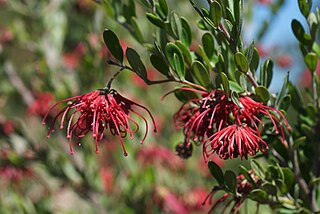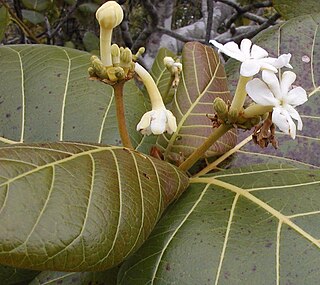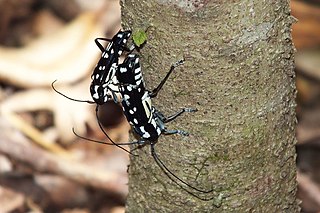
Ceiba is a genus of trees in the family Malvaceae, native to tropical and subtropical areas of the Americas and tropical West Africa. Some species can grow to 70 m (230 ft) tall or more, with a straight, largely branchless trunk that culminates in a huge, spreading canopy, and buttress roots that can be taller than a grown person. The best-known, and most widely cultivated, species is Kapok, Ceiba pentandra, one of several trees called kapok.

Mitragyna speciosa is a tropical evergreen tree in the coffee family native to Southeast Asia. It is indigenous to Thailand, Indonesia, Malaysia, Myanmar, and Papua New Guinea, where it has been used in herbal medicine since at least the nineteenth century. Kratom has opioid properties and some stimulant-like effects.

The silk floss tree is a species of deciduous tree native to the tropical and subtropical forests of South America. It has several local common names, such as palo borracho or árbol del puente, samu'ũ or paineira. In Bolivia, it is called toborochi, meaning "tree of refuge" or "sheltering tree". It belongs to the same family as the baobab and the kapok. Another tree of the same genus, Ceiba chodatii, is often referred to by the same common names.

Glenealy is one of the few roads or streets without a suffix in Hong Kong. Located in the Mid-Levels on the Hong Kong Island, Hong Kong, it starts from Ice House Street and goes uphill to Hong Kong Zoological and Botanical Gardens, across Robinson Road and ends at Hornsey Road and Conduit Road.

Lagerstroemia speciosa is a species of Lagerstroemia native to tropical southern Asia.

Banksia speciosa, commonly known as the showy banksia, is a species of large shrub or small tree in the family Proteaceae. It is found on the south coast of Western Australia between Hopetoun (33°57′ S) and the Great Australian Bight, growing on white or grey sand in shrubland. Reaching up to 8 m (26 ft) in height, it is a single-stemmed plant that has thin leaves with prominent triangular "teeth" along each margin, which are 20–45 cm (7.9–17.7 in) long and 2–4 cm (0.8–1.6 in) wide. The prominent cream-yellow flower spikes known as inflorescences appear throughout the year. As they age they develop up to 20 follicles each that store seeds until opened by fire. Though widely occurring, the species is highly sensitive to dieback and large populations of plants have succumbed to the disease.

Glenealy is a village 8 km (5.0 mi) west of Wicklow Town, in County Wicklow, on the R752. The Dublin - Rosslare railway line also passes through the village.

Chaenomeles speciosa, the flowering quince, Chinese quince, or Japanese quince, is a thorny deciduous or semi-evergreen shrub native to eastern Asia. It is taller than another commonly cultivated species, C. japonica, usually growing to about 2 m. The flowers are usually red, but may be white or pink. The fruit is a fragrant but hard pome that resembles a quince.

Banksia splendida, commonly known as shaggy dryandra, is a species of shrub that is endemic to the southwest of Western Australia. It has sharply-pointed linear leaves that are woolly on the lower surface, cream-coloured and maroon or yellow flowers in heads of between 65 and 115, and later up to eight egg-shaped follicles in each head.

7-Hydroxymitragynine is a terpenoid indole alkaloid from the plant Mitragyna speciosa, commonly known as Kratom. It is often referred to as ‘7-OH’. It was first described in 1994 and is a natural product derived from the mitragynine present in the Kratom leaf. It is considered an oxidized derivative and active metabolite of mitragynine.

Grevillea speciosa, also known as red spider flower, is a shrub which is endemic to New South Wales in Australia.

Guettarda speciosa, with common names sea randa, or zebra wood, is a species of shrub in the family Rubiaceae found in coastal habitats in tropical areas around the Pacific Ocean, including the coastline of central and northern Queensland and Northern Territory in Australia, and Pacific Islands, including Micronesia, French Polynesia and Fiji, Malaysia and Indonesia, Maldives and the east coast of Africa. It reaches 6 m in height, has fragrant white flowers, and large green prominently-veined leaves. It grows in sand above the high tide mark.
Banksia splendida subsp. macrocarpa is a subspecies of Banksia splendida. It was known as Dryandra speciosa subsp. macrocarpa until 2007, when Austin Mast and Kevin Thiele sunk all Dryandra into Banksia. Since there was already a species named Banksia speciosa, Mast and Thiele had to choose a new specific epithet for D. speciosa and hence for this subspecies of it. As with other members of Banksia ser. Dryandra, it is endemic to the South West Botanical Province of Western Australia.
Banksia splendida subsp. splendida is a subspecies of Banksia splendida. It was known as Dryandra speciosa subsp. speciosa until 2007, when Austin Mast and Kevin Thiele sunk all Dryandra into Banksia. Since the name Banksia speciosa had already been used, Mast and Thiele had to choose a new specific epithet for D. speciosa and hence for this subspecies of it. As with other members of Banksia ser. Dryandra, it is endemic to the South West Botanical Province of Western Australia. As an autonym, it is defined as encompassing the type material of the species.

Xestia speciosa is a moth of the family Noctuidae. It is found in northern Europe, including Fennoscandia, the Baltic region, parts of Russia and further through northern Asia to the Pacific Ocean and Japan. It is also found in the mountainous areas of central and southern Europe. It is also present in north-western North America.

Glenealy Hurling Club is a Gaelic Athletic Association club located in the parish of Glenealy and Ashford in County Wicklow, Ireland. The club was founded in 1885 as a football club but switched codes to the game of hurling in the early 1920s.
Speciosa is an Irish-bred, British-trained Thoroughbred racehorse. In a racing career which lasted from June 2005 and October 2007 she ran seventeen times and won four races. As a two-year-old, she won two of her six races including an upset win in the Group Two Rockfel Stakes at Newmarket Racecourse. As a three-year-old she won the Nell Gwyn Stakes and then took the Classic 1000 Guineas for her trainer and part owner Pam Sly. She failed to win in nine subsequent races although she placed second in the Earl of Sefton Stakes and the Pretty Polly Stakes. She was retired at the end of the 2007 season to become a broodmare. Her front-running style and unconventional background made her a popular Classic winner.

Glenea is a genus of longhorn beetles belonging to the family Cerambycidae, subfamily Lamiinae.

Glenea venus is a species of beetle in the family Cerambycidae. It was described by James Thomson in 1865. It is known from Papua New Guinea, Australia and Indonesia.

Protea speciosa, also known as the brown-beard sugarbush, is a flowering shrub which is classified as within the genus Protea.
















